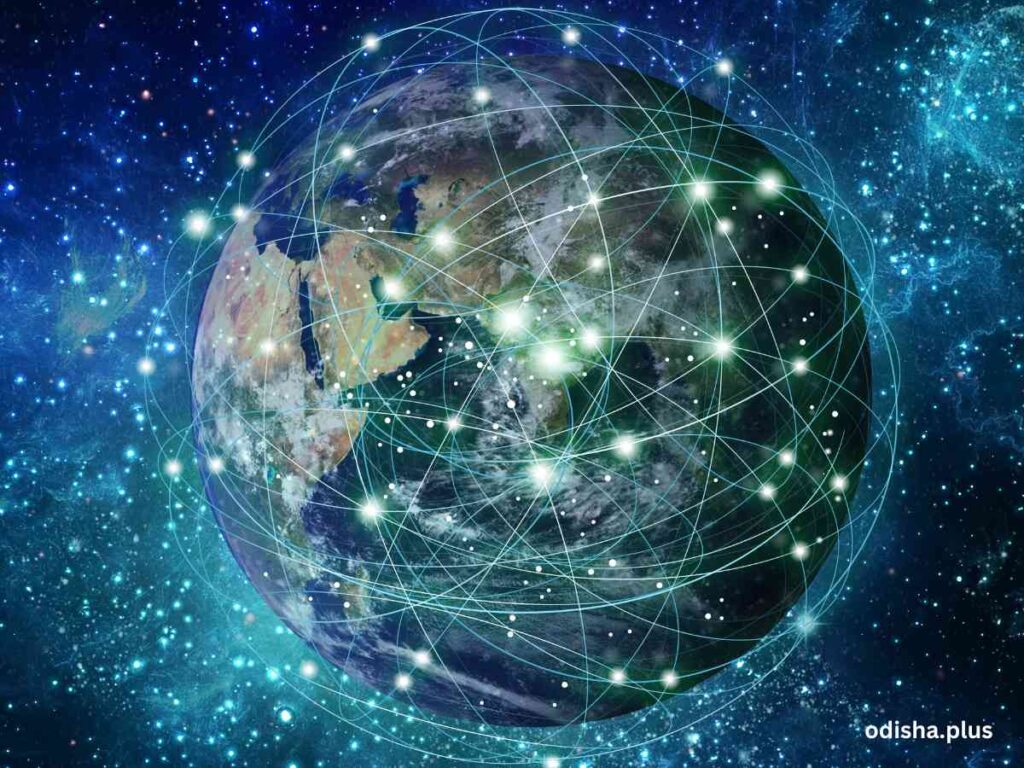Digital Earth can be utilized effectively across various domains to safeguard the environment and preserve planet Earth
Dr Navya Gubbi Sateeshchandra & Dr Samrat Ray

Digital Earth shows a transformative movement to how humanity recognizes, tracks, and communicates with the environment. Progress has been seen towards the Anthropocene Epoch, where activities associated with humans essentially impact the ecosystems and climate conditions of the planet. In this context, the key functions of Digital Earth as considered the ‘Human Super-Sense’ have been extremely important.
This specific advanced digital model, supported by interconnected digital platforms, AI-Artificial Intelligence, and geospatial technologies can offer unparalleled and dynamic information and knowledge about environmental changes, thereby supporting sustainable development initiatives and helping disaster responses across the globe.
Digital Earth is considered important as a digital twin of Earth, thereby leveraging effective simulations and real-time data to develop a detailed, exclusive, and communicative image of Earth. This image or representation supports the public, scientists, and decision-makers in understanding the intricate environmental procedures and their effects or implications.
Like how the HD maps support CAVs-Connected and Autonomous Vehicles in navigation, Digital Earth completely depends on diverse modal data sources including AI-supported analytics, sensor networks, and satellite imagery to monitor the environmental singularities with notable accuracy.
Digital Earth can be effectively used in diverse aspects to protect the environment and the planet Earth. The following aspects are discussed below in a detailed manner.
It cannot be denied that climate change has been an extremely demanding environmental issue in this modern era. As a result, Digital Earth has been aiding climate action by helping and developing effective data-oriented decisions. For example, IMEO – International Methane Emissions Observatory monitors methane emissions from diverse channels.
Therefore, by allowing transparent and clear reporting, and exploring the emission hotspots, IMEO has been authorizing industries and governments to deploy targeted reduction tactics, thereby significantly contributing to global warming mitigation.
Air pollution has still been an important global health concern thereby creating large millions of premature deaths per annum. In this context, Digital Earth, via different platforms such as UNEP’s GEMS Air – Global Environment Monitoring System for Air, offers real-time data on air quality for a large number of cities across the globe. By incorporating this particular data in mobile health applications and public information channels, policymakers and individuals can develop proactive measures to address the negative impacts of pollution.
Biodiversity strengthens the well-being of humans and resilience in the ecosystem. In this context, the United Nations Biodiversity Lab 2.0 has been an effective tool for monitoring the loss of biodiversity, climate change implications, and human infringement on natural habitats. Thus, this particular platform helps conservation initiatives by offering updated and accessible spatial information to efficiently navigate habitat and sustainable land-use planning protection.
Freshwater ecosystems are considered essential for retaining life. However, it is extremely threatened by climate change, overexploitation, and pollution. The explorer of the freshwater ecosystem provides a comprehensive evaluation of wetlands, rivers, and lakes across the world. By envisaging movements or changes in the water bodies over a period, policymakers can deploy effective measures to safeguard these important key resources and assure their availability for the upcoming generations.
Digital Earth further can guide sustainable food and agriculture security. By leveraging climate models and satellite imagery, farmers can access real-time information regarding water availability, crop health, and soil conditions. Accurate agriculture practices supported by this particular data, minimize extra water utilization, reduce the application of pesticides, and raise yields, thereby assuring more effective resource usage while safeguarding the natural ecosystems.
Digital Earth has huge potential to protect the planet Earth through emerging and innovative strategies. Digital Earth presents a promising avenue for fostering sustainable urban development. Concerning accelerations of global urbanization, Digital Earth technologies have the ability to guide city planners in effectively organizing and designing environmentally-friendly cities by evaluating the trends and patterns of green space distribution, transportation flows, and energy consumption. Smart city strategies that incorporate geospatial data can enhance the development of the infrastructure while reducing adverse environmental effects.
Natural disasters such as floods, earthquakes, hurricanes, and wildfires have been creating extreme increased uncertainties because of human activities and climate changes. Here, Digital Earth can essentially improve the readiness, response, and recovery of disasters by deploying predictive modeling, advanced simulations, and real-time tracking. Furthermore, by leveraging AI-supported analytics, ground-based sensors, and satellite imagery, it can offer early and primary alerts and enhance effective decision-making during crisis periods.
For example, satellite-associated primary alter or warning systems can identify woodfire hotspots thereby allowing proactive firefighting initiatives, on-time evacuations, and resource mobilization. Additionally, predictive flood systems or models can predict events such as river overflow thereby helping key authorities to deploy major precautionary protocols and safeguard vulnerable communities and their people. By aligning past climate trends with high-resolution geospatial data, more precise models can be developed to forecast extreme weather events such as cyclones and hurricanes.
The damage evaluation after the disasters supported by Digital Earth technologies helps in the effective revamping of the planning and resource allocation. By leveraging satellite imagery and drones, response teams can immediately evaluate impacted regions, prioritize support, and monitor recovery progress.
Moreover, the Digital Earth helps in doing international partnership by offering open-access data platforms for global response efforts thereby fostering a more synchronized and efficient strategy for disaster management. Therefore, this depicts that Digital Earth is regarded as an efficient tool to protect ecosystems, property, and lives from the increasing threats created by natural disasters.
It is extremely important to mitigate the social, legal, and ethical implications of Digital Earth as the technologies are evolving continuously. In this present context, responsible AI implementation, equitable access, and data privacy are important factors to consider. Collaborative frameworks like the Coalition for Digital Environmental Sustainability foster global support in developing policies, best practices, and guidelines associated with ethical data use.
Assuring equal accessibility to the Digital Earth tools and technologies is significant for preventing a data division between developing and developed countries. Additionally, openness and clarity in data accumulation, processing, and leveraging need to be upheld to develop trust among the general public and key stakeholders.
The possible misutilization of Digital Earth technologies especially for biased, surveillance, or unfair decision-making shows further ethical concern. Civil society, technologies, and policymakers need to collaborate together as a team to develop strong protections that maintain individual rights while using the advantages of these key technologies. Moreover, educational programs and public awareness campaigns can develop a comprehended interpretation of the ethical dimensions associated with Digital Earth.
Moving forward, the advancement of Digital Earth is prepared to enhance with the developments in cloud computing, AI, and IoT – the Internet of Things. In addition, improved global collaborations and data-sharing frameworks shall be important in addressing the policy and technical associated issues. Moreover, as a greater number of key stakeholders understand the worth of Digital Earth in meeting environmental sustainability, the incorporation of each of the tools in the community efforts and mainstream governance strategies shall likely increase.
Additionally, key innovations in geospatial analytics, amalgamated with rising computational power, can allow more precise estimations of environmental alterations. Furthermore, policymakers can make effective sound decisions to mitigate key global issues by uninterruptedly upgrading the digital twins with real-time data. Additionally, leveraging the Machine Learning – ML algorithms can improve the abilities of the pattern recognition thereby offering detailed information about the environmental anomalies and trends.
Moreover, the advancement of user-friendly platforms shall further decentralize accessibility to Digital Earth technologies, thereby allowing researchers, governments, individuals, and local communities to engage in environmental stewardship. Cross-industry partnerships between environmental companies, academia, and technology organizations can drive innovation and execution.
Digital Earth demonstrates an inspiration of courage to protect the planet Earth, thereby promoting adaptability and supporting humanity toward a sustainable future. Also, with continuous research, investment, and global collaboration, this particular digital ecosystem can be an essential tool for a healthier and more sustainable world.
Therefore, it is evident that Digital Earth is considered one of the key technological and scientific achievements in this modern era of the 21st century. By fortifying the strength of digital technologies and data, more comprehended knowledge and information about environmental changes can be gathered, thereby helping in developing efficient mitigation tactics and fostering global sustainability. The key issues associated with biodiversity loss, pollution, and climate change continue to be addressed, and as a result, the Digital Earth has been a foundation for protecting the planet Earth for future generation.
(Dr Navya is a Professor at Berlin School of Business & Innovation, Berlin, Germany & Dr Samrat is Dean at IIMS, Pune. Views expressed are personal.)

























